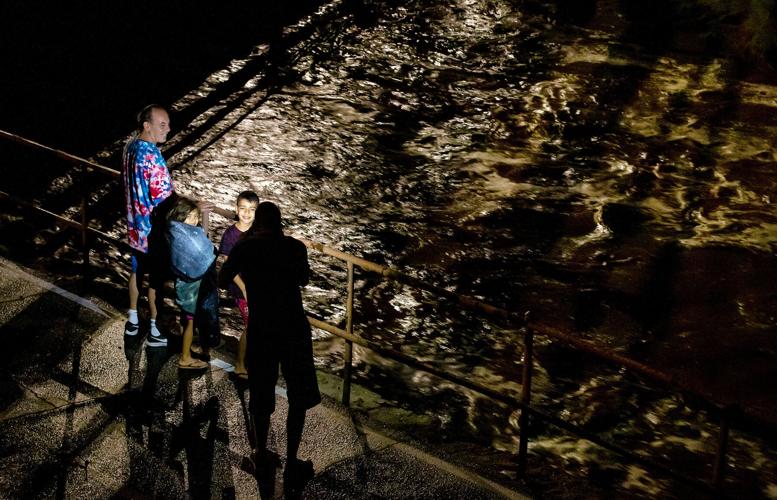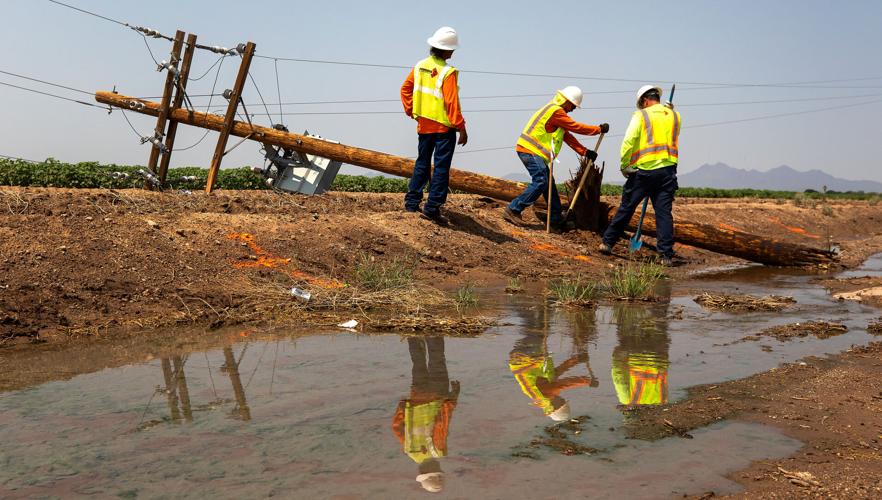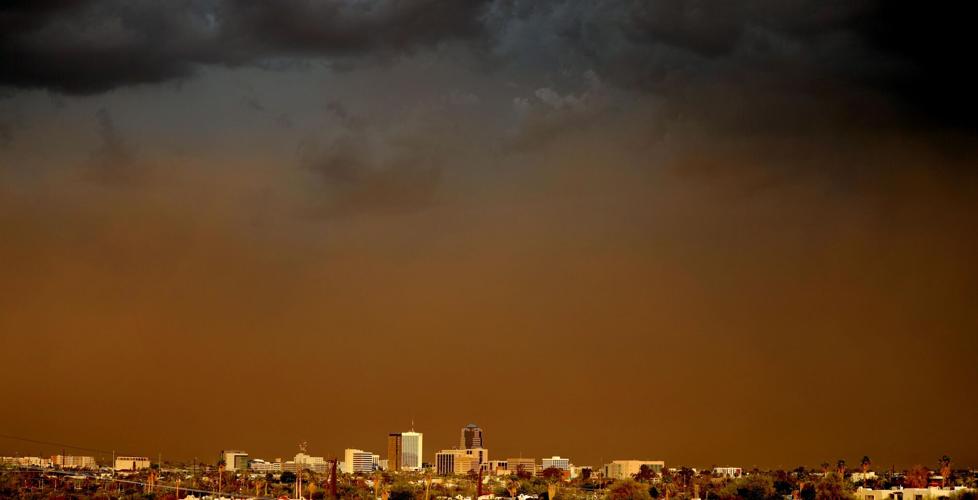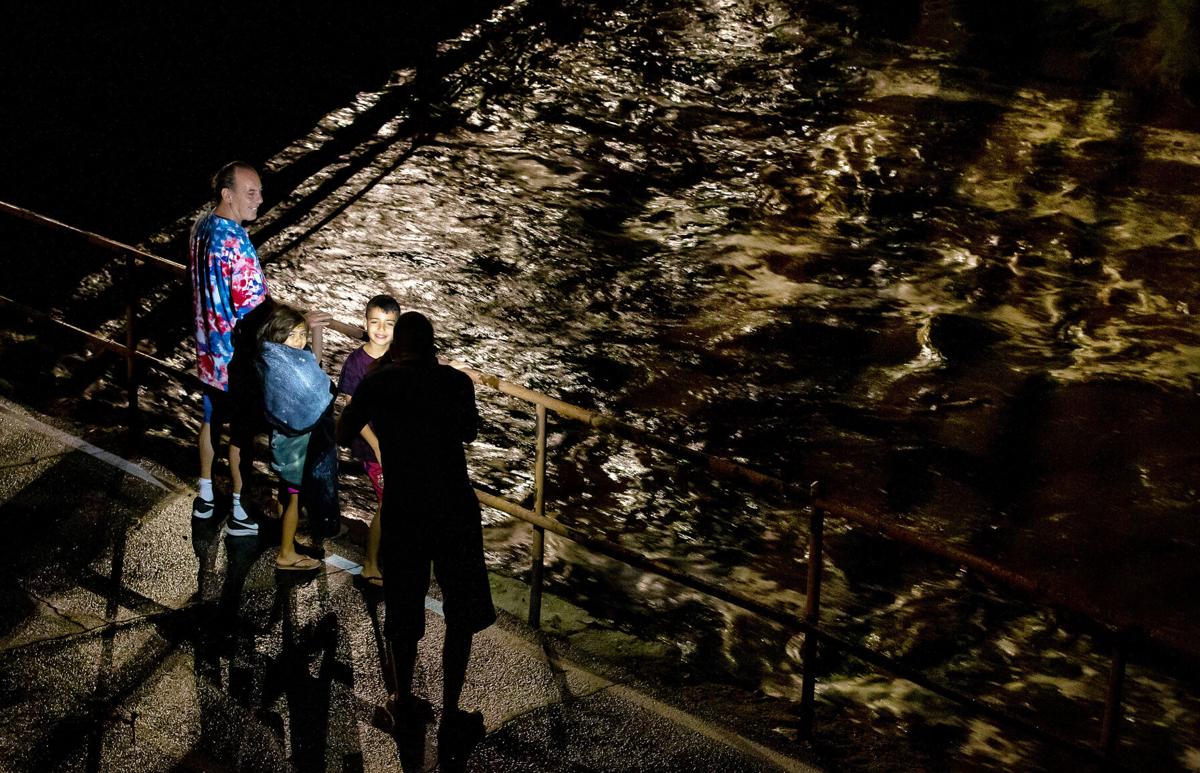After a Monday deluge that saw rainfall of more than an inch in some areas, a flash-flood warning is in effect for Tucson and most of Southeastern Arizona through Wednesday evening.
“There’s certainly, we think, some increased or enhanced potential that some of the thunderstorms, should they occur, will produce areas of heavy rainfall,” said meteorologist Glenn Lader with the National Weather Service in Tucson.
A microburst over the Tucson's Foothills area was captured in a video Friday from the University of Arizona Hydrology and Atmospheric Sciences. A microburst is the core of a thunderstorm that drops down in a precipitation column and produces strong wind and heavy rain, says Mike Leuthold, the manager at the Regional Weather Modeling Program.
That potential for thunderstorms should last for the next seven to 10 days, according to Lader, likely adding to the region’s rainfall totals. After Monday’s downpour, the NWS reported Tucson had already surpassed its entire 2020 monsoon season precipitation total.
While the 2020 monsoon season saw a near-historic low in total rainfall at 1.62 inches, the official total of 0.39 inches recorded at Tucson International Airport on Monday night pushed this year’s monsoon total to 1.64 inches.

Workers from Trico Electric Cooperative begin replacing downed utility poles on West Marana Road on Tuesday morning. Areas of the town lost power during Monday night’s monsoon storm. Thunderstorms remain a possibility for the next seven to 10 days.
Following up a historically dry year with an above-average monsoon season is something with precedent. According to NWS Tucson, after the 10 driest monsoon seasons on record, six of them were followed by above-average precipitation years.
“That certainly doesn’t mean that there’s going to be rain every day or anything like that. But the overall pattern is a pretty good one,” Lader said.

A haboob dwarfs the Tucson skyline on July 10, 2021. Behind the dust: Heavy rain, winds, and lightning.
Lader also noted that it is too early to draw any conclusions about how much wetter or drier the rest of the monsoon season, which officially ends on Sept. 30, will be.
“The new outlook doesn’t come out for another few days from the Climate Prediction Center,” he said. “The official outlook for July, August, September, for that three-month period is for equal chances of above, below, or near normal precipitation.”“
Photos: Monsoon 2021
Rillito River after Tropical Storm Nora
Updated
It was clear skies at sunset over the Rillito River, running almost bank-to-bank near its junction at the Santa Cruz River, September 1, 2021, the day after Tropical Storm Nora dumped several hours of rain on Tucson, Ariz.
Tropical storm Nora
Updated
Pedestrians walk though the soaked intersection of Congress and 6th as the remnants of tropical storm Nora drops evening rains over Tucson, Ariz., August 31, 2021.
Storm Preparation
Updated
People fill up sandbags at Hi Corbett Field as clouds roll over in Tucson, Ariz. on August 30, 2021. Tropical Storm Nora is expected to bring heavy rain and cause more flooding.
Storm Preparation
Updated
Elaine Gomez. center, receives help from her sister-in-law, Lucyann Trujillo, right, in filling sandbags near Hi Corbett Field in Tucson, Ariz. on August 30, 2021. Gomez lives near 19th Street and Craycroft Road and says the house flooded a couple of weeks ago. Tropical Storm Nora is expected to bring heavy rain and cause more flooding.
Storm Preparation
Updated
People fill up sandbags at Hi Corbett Field as clouds roll over in Tucson, Ariz. on August 30, 2021. Tropical Storm Nora is expected to bring heavy rain and cause more flooding.
Monsoon
Updated
An air cargo plane lifts off from Tucson, Ariz., International Airport in front of a monsoon storm boiling up to the southeast in the Huachuca City/Sierra Vista area, August 24, 2021.
Monsoon
Updated
The last of the day's light hits the upper reaches of a monsoon storm cloud over an utility tower east of Tucson, Ariz., August 18, 2021.
Monsoon
Updated
A man and his dog skirt a flooded section of The Loop along the Rillito River near Swan Road following Tuesday’s monsoon over central Tucson.
Monsoon
Updated
An evening monsoon storm cloud drops a column of rain over central Tucson, Ariz., August 17, 2021.
Monsoon
Updated
A woman wades into the flood waters of the Rillito River just west of Swan Road after an afternoon monsoon storm through the center of town got the washes flowing, Tucson, Ariz., August 17, 2021.
Monsoon, 2021
Updated
Monsoon clouds clear as the sun sets near the Santa Catalina Mountains on Aug. 2, 2021.
Arizona Weather
Updated
A woman climbs out of a Nissan pick-up as firefighters from Northwest Fire District position themselves for a water rescue in the Cañada del Oro Wash north of Tucson, Ariz., on Aug. 10, 2021. Firefighters rescued three people from one of two vehicles in the wash, swollen with runoff after an early-morning downpour dumped nearly two-inches upstream.
Monsoon
Updated
Several bolts strike in the foothills of the southern Rincon Mountains as an intense monsoon cell rolls into Vail, Ariz., July 30, 2021.
Monsoon
Updated
A heavy bolt of lightning hits in the foothills of the southern Rincon Mountains as an intense monsoon cell rolls into Vail, Ariz., July 30, 2021,
Monsoon
Updated
A heavy bolt of lightning hits in the foothills of the southern Rincon Mountains as an intense monsoon cell rolls into Vail on Friday night.
Monsoon lightning 2021
Updated
Lighting strikes southwest of Tucson, Ariz., July 29, 2021, from one of several monsoon cells that moved through valley just before sunset.
Monsoon lightning 2021
Updated
Several fingers of lighting strike southwest of Tucson, Ariz., July 29, 2021, from one of several monsoon cells that moved through and around the valley just before sunset.
Monsoon lightning 2021
Updated
Lighting hits southwest of Tucson, Ariz., July 29, 2021, as several monsoon storms roll over the outskirts of the city just before sunset.
Monsoon lightning 2021
Updated
A bolt of lighting hits in the Santa Catalina foothills in the northwest part of Tucson, Ariz., July 29, 2021, as several monsoon storms rolled over the outskirts of town.
Monsoon lightning 2021
Updated
A lighting strikes drops out of a monsoon squall moving just southwest of Tucson, Ariz., July 29, 2021, one of several cells that surrounded the city just before sunset.
Monsoon lightning 2021
Updated
A lighting strikes hits in the Saguaro National Park, east of Tucson, Ariz., July 29, 2021, one of several storm cells that skirted the city.
Monsoon lightning 2021
Updated
A lighting strikes hits in the Saguaro National Park, east of Tucson, Ariz., July 29, 2021, one of several storm cells that skirted the city.
Monsoon, Sabino Creek
Updated
Tessa Claiborn, 10, jumps in a pool near the bottom of the Sabino dam at Sabino Canyon Recreational Area, 5700 N. Sabino Canyon Rd., in Tucson, Ariz. on July 26th, 2021. After being dry last year, the weekend monsoon storms brought a large flow of water back through the Sabino Creek and over the Sabino Dam.
Monsoon, Sabino Creek
Updated
A gentleman rest on a rock near the bottom of the Sabino dam at Sabino Canyon Recreational Area, 5700 N. Sabino Canyon Rd., in Tucson, Ariz. on July 26th, 2021. After being dry last year, the weekend monsoon storms brought a large flow of water back through the Sabino Creek and over the Sabino Dam.
Monsoon, Sabino Creek
Updated
A hiker walks past an ocotillo with lush green leaves along the Bear Canyon trail at Sabino Canyon Recreational Area, 5700 N. Sabino Canyon Rd., in Tucson, Ariz. on July 26th, 2021. After being dry last year, the weekend monsoon storms brought a large flow of water back through the Sabino Creek and over the Sabino Dam.
Monsoon, Sabino Creek
Updated
A group of saguaro cacti are surrounded by ocotillo and lush green scenery along the Bear Canyon trail with green lush scenery at Sabino Canyon Recreational Area, 5700 N. Sabino Canyon Rd., in Tucson, Ariz. on July 26th, 2021.
Monsoon, Sabino Creek
Updated
Judy Scharringhausen takes a picture of a patch of greenery along the Bear Canyon trail at Sabino Canyon Recreational Area, 5700 N. Sabino Canyon Rd., in Tucson, Ariz. on July 26th, 2021.
Monsoon, Sabino Creek
Updated
Hikers walk along the Bear Canyon trail with green lush scenery at Sabino Canyon Recreational Area, 5700 N. Sabino Canyon Rd., in Tucson, Ariz. on July 26th, 2021.
Monsoon, Sabino Creek
Updated
In 2020, the Sabino Canyon creek was dry for 216 days, the most since 1990. Then we went abruptly to the wettest month in Tucson history in July 2021. Here, a Sabino Canyon visitor, Brad Balla, sits on a rock near the bottom of the Sabino Dam last month.
Monsoon storm, July, 2021
Updated
The Rillito River rolling along just west of Swan Road after a powerful storm with heavy rain over the Tucson area early Friday, July 23, 2021.
Monsoon, Santa Cruz River
Updated
The Santa Cruz River flows Friday morning July 23, 2021 after an overnight monsoon storm passed over in Tucson, Ariz.
Monsoon storm, July, 2021
Updated
The Rillito River east of 1st Ave. after a powerful storm with heavy rain over the Tucson area early Friday, July 23, 2021.
Monsoon storm, July, 2021
Updated
A cyclist photographs the Rillito River from The Loop path east of 1st Ave. a powerful storm with heavy rain over the Tucson area early Friday, July 23, 2021.
Monsoon storm, July, 2021
Updated
A truck enters Pima Wash on Rudasill Road after a powerful storm with heavy rain over the Tucson area early Friday, July 23, 2021.
Monsoon storm, July, 2021
Updated
A vehicle that was washed downstream in Alamo Wash sits just south of the bridge at Ft. Lowell Road after a powerful storm with heavy rain over the Tucson area early Friday, July 23, 2021. Tucson firefighters rescued the woman from the water in a call that began at Sahuara Ave. and Waverly St.
Monsoon flooding, July 2021
Updated
The flooded Pantano Wash draws crowds of onlookers where it cuts off Harrison Road following a night of intense monsoon storms, Tucson, Ariz., July 23, 2021.
Monsoon flooding, July 2021
Updated
Terry Shaeffer gets cell phone video of the the waters of Pantano Wash roaring over Harrison Road following a night of intense monsoon storms, Tucson, Ariz., July 23, 2021.
Monsoon flooding, July 2021
Updated
Steven Walden grabs video of the flooding Pantano Wash near Colossal Cave Road following a night of intense monsoon storms, Tucson, Ariz., July 23, 2021.
Monsoon flooding, July 2021
Updated
The parking area of the La Cienega Trailhead is flooded out from the nearby Pantano Wash following a night of intense monsoon storms, Tucson, Ariz., July 23, 2021.
Monsoon flooding, July 2021
Updated
People walk along the Pantano Wash as bank-to-bank water flows by near Colossal Cave Road following a night of intense monsoon storms, Tucson, Ariz., July 23, 2021.
Monsoon flooding, July 2021
Updated
A couple of men in a cart cruise along the Pantano Wash paths near the flooded channel near Colossal Cave Road following a night of intense monsoon storms, Tucson, Ariz., July 23, 2021.
Monsoon storm, July, 2021
Updated
The rolling Rillito River west of Swan Road after a powerful storm with heavy rain over the Tucson area early Friday, July 23, 2021.
Possible water rescue
Updated
A Tucson firefighter keeps an eye on the Alamo Wash behind Park Place after callers reported child was in the wash on July 22nd, 2021. There was no child in the wash but TFD watched the wash as a precaution.
Possible water rescue
Updated
A full and rapid Alamo Wash behind Park Place Mall in Tucson, Ariz. on July 22nd, 2021.
Sandbag
Updated
Julia Andres, left, and her husband David Andres fill sand bags for their home at Hi Corbett Field parking lot in Tucson, Ariz. on July 22nd, 2021. The City of Tucson is offering free self-serve sand bags at numerous vacations through out Tucson. There is a ten bag limit per vehicle. Sand bags and sand are provided but residents will need to bring their own shovel.
Sandbag
Updated
Residents fill sand bags at Hi Corbett Field parking lot in Tucson, Ariz. on July 22nd, 2021. The City of Tucson is offering free self-serve sand bags at numerous vacations through out Tucson. There is a ten bag limit per vehicle. Sand bags and sand are provided but residents will need to bring their own shovel.
Monsoon
Updated
A bolt of lightning illuminates a column of rain drenching midtown, part of a powerful monsoon cell that dropped rain, winds and hail over parts of Tucson, Ariz., July 20, 2021.
Monsoon
Updated
A bolt of lightning strikes the southeastern part of town as a powerful monsoon cell moves into central Tucson, Ariz., July 20, 2021.
Monsoon
Updated
Lightning hits the southern part of the city as a powerful monsoon cell moves through central Tucson, Ariz., July 20, 2021.
Monsoon
Updated
Lightning and rain fall on the southern parts of the city as a powerful monsoon cell rolls through central Tucson, Ariz., July 20, 2021.
Monsoon
Updated
Cloud-to-cloud lightning rips through the skies over the Santa Catalina Mountains, part of a second monsoon cell that skirted the northern parts of Tucson, Ariz., July 20, 2021.
Monsoon
Updated
From a spot in the Saguaro National Park East, George Lucero gets video of the day's monsoon storms working over the Tanque Verde Valley, Tucson, Ariz., July 16, 2021. A persistent light rain fell over the eastern reaches of the valley throughout the afternoon
Monsoon
Updated
Monsoon storm clouds filter the sun light as a day of rain, mostly in the eastern parts of the valley, comes to an end, Tucson, Ariz., July 16, 2021.
Monsoon
Updated
A biker crosses over the flooded Canyon del Oro wash on The Loop bridge where the waters flow into the Santa Cruz River in the aftermath of an early morning monsoon storm that dumped inches of rain on the northwest side, Tucson, Ariz., July 14, 2021.
Monsoon
Updated
A biker on the Rillito River Park paths pedals next to the muddy waters in the channel as he heads east under the Craycroft Road bridge after an overnight monsoon storm dropped heavy rains on the north and west parts of the valley, Tucson, Ariz., July 14, 2021.
Monsoon
Updated
The dark muddy water in the Canyon del Oro wash falls over a spillway under I-10 near the confluence with the Santa Cruz River in the aftermath of an early morning monsoon storm that flooded washes and low lying areas, Tucson, Ariz., July 14, 2021.
Monsoon 2021, CDO Wash
Updated
Cañada del Oro Wash flowing with runoff from several monsoon storms flowing onto The Loop bike trail at Magee Road on July 14, 2021.
Monsoon 2021, CDO Wash
Updated
Cañada del Oro Wash flowing with runoff from several monsoon storms on July 14, 2021.
Monsoon 2021, CDO Wash
Updated
The unbridged crossing at Overton Road and the Cañada del Oro Wash was closed to traffic, but open for photos on July 14, 2021.
Monsoon 2021, CDO Wash
Updated
Cañada del Oro Wash flowing with runoff from several monsoon storms as seen from the bridge at La Cholla Blvd. on July 14, 2021.
Monsoon 2021, CDO Wash
Updated
The unbridged crossed at Overton Road and Cañada del Oro Wash closed to traffic due to runoff from several monsoon storms on July 14, 2021.
Monsoon 2021, CDO Wash
Updated
A cyclists gingerly proceeds along The Loop bike trail along the Cañada del Oro Wash flowing as runoff from several monsoon storms overlooks the banks on July 14, 2021.
Monsoon
Updated
A pair of bikers ride under the sunset sky under monsoon clouds along the Rillito River Park paths near Columbus Avenue, Tucson, Ariz., July 13, 2021. The rains bypassed the city for the most part Tuesday following heavy storms the day before.
Monsoon, 2021
Updated
Trico Electric Cooperative workers respond to a fallen power pole on W. Marana Rd. in Marana, Ariz. on July 12th, 2021. Areas of Marana lost power due to Monday night's monsoon storm.
Monsoon, 2021
Updated
A group of people take photos as water flows in the Rillito River at N. Campbell Ave. in Tucson July 12th, 2021. With at total of 1.63" of rainfall in this years monsoon season has surpassed last years total rainfall, according to the National Weather service.
Monsoon
Updated
Pedestrians negotiate the flooded intersection of Tyndall and University in Maingate Square as heavy rain drops on the area as part of the large monsoon storm that swept through Tucson, Ariz., July 10, 2021.
Monsoon
Updated
A wall of dust dwarfs downtown as a haboob leads a large monsoon storm into the area, Tucson, Ariz., July 10, 2021. In addition to the haboob the storm dropped heavy rain, winds, lightning and dust over the valley.
Monsoon
Updated
A dove fights the winds as the dust forms a haboob and darkens the skies as a large monsoon storm sweeps through the area, Tucson, Ariz., July 10, 2021.
Monsoon
Updated
Dust from a haboob obscures the skyline, the precursor to a large monsoon storm that swept through the area, Tucson, Ariz., July 10, 2021.
Monsoon
Updated
A pedestrian negotiates flooded Euclid Avenue near 2nd Street as heavy rains from a large monsoon storm inundate Tucson, Ariz., July 10, 2021.
Monsoon
Updated
Lightning flashes over the Santa Rita Mountains from one of the scattered monsoon storms surrounding Tucson, Ariz., July 7, 2021.
Monsoon, 2021
Updated
Several powerlines blew over on First Ave between River Road and Wetmore Road due to a monsoon storm with strong winds in Tucson, Ariz. on July 2, 2021.
Monsoon, 2021
Updated
A man walks along First Ave. in between Wetmore Road and River Road looking at the water flowing in the Rillito River due to a monsoon storm that passed through Tucson, Ariz. on July 2, 2021.
Monsoon, 2021
Updated
A man walks past a powerline that fell over on First Ave. between Wetmore Road and River Road due to a monsoon storm that passed through Tucson, Ariz. on July 2, 2021.
Monsoon, 2021
Updated
The Rillito River flows near First Ave and Wetmore Road after a monsoon storm passed over the area in Tucson, Ariz. on July 2, 2021.
Monsoon, 2021
Updated
Two men walk up to the scene where a monsoon storm with strong winds knocked over several powerlines on First ave between Wetmore Road and River Road in Tucson, Ariz. on July 2, 2021.
Monsoon 2021
Updated
A downed tree lays over gravestones at Evergreen Mortuary & Cemetery, 3015 N Oracle Road in Tucson, Ariz., on July 1, 2021. According to Cathy Fiorelli, general manager, a microburst passed through the area on Wednesday afternoon at 2:15p.m. knocking down 35 trees. She says no burials are disturbed.
Monsoon 2021
Updated
The sun sets behind monsoon clouds and rain to the west of Tucson Mountain Park, Tucson, Ariz., July 1, 2021.
Monsoon 2021
Updated
Traffic splashes through the run-off on Ina Road near Pima Canyon Drive during localized monsoon downpour, Tucson, Ariz., July 1, 2021.
Monsoon
Updated
As a monsoon storm builds behind them, Jacob Runyan, left, and Michele Bayze watch the clouds and rain roll over the valley in front of them from a boulder at Windy Point in the Santa Catalinas, Tucson, Ariz., June 30, 2021.
Monsoon
Updated
Rains rolls down the Tanque Verde Valley behind an agave bloom in the Santa Catalinas, part of a monsoon storm trickling into the valley, Tucson, Ariz., June 30, 2021.
Monsoon
Updated
A couple watch as a monsoon storm begins to drop rain in the eastern reaches of the Santa Catalinas from a lookout near Windy Point, Tucson, Ariz., June 30, 2021.
<&rdpStrong>6 flash flood safety tips to help keep you safe this monsoon season</&rdpStrong>
6 flash flood safety tips to help keep you safe this monsoon
Check the forecast
Updated
Before you head out, check the weather forecast for expected storm activity. Floods can be caused by rainfall miles away.
Avoid afternoon hikes
Updated
If you go hiking, only hike in the morning. Storms usually occur in the afternoons and evenings.
Don't risk it
Updated
If you see dark clouds or lightning, or if you hear thunder, pack up and go home. Flooding happens suddenly and without warning, the Pima County Sheriff's Department warned.
Avoid areas prone to flooding
Updated
Stream beads, narrow canyons and washes are all subject to flooding. Also, if you see an area with flash flood warning signs posted, be extra cautious.
Avoid flowing water
Updated
Do not cross any flowing water or flooded trails, in your car or on foot. If there's flowing water, find another route.
Move to higher ground
Updated
If you see or hear a flood coming, don't try to outrun it. Search and move to higher ground as quickly as you can.





